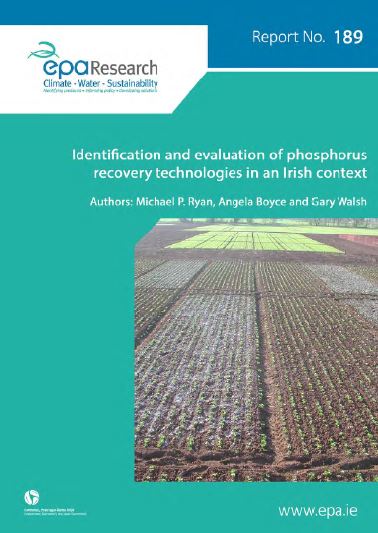Authors: Michael P. Ryan, Angela Boyce and Gary Walsh
Summary: Research report 189 on Identification and evaluation of phosphorus recovery technologies

Phosphorus is essential for all life and the depletion of global phosphorus deposits; widening supply-demand gap and security of supply risks have economic, social and environmental implications especially in relation to food production and security for a growing population. Phosphorus cannot be produced synthetically and has no substitute in food production. Almost all of the phosphorus consumed in food by the global population enters the wastewater sector. Municipal wastewater therefore represents a major point source to recover phosphorus and re-establish a circular economy. This research identified and evaluated technologies available for phosphorus recovery from municipal wastewater which could be implemented to generate marketable recycled phosphorus products in an Irish context. This research also examined the current phosphorus market, potential outlets for recovered phosphorus and the associated quality and regulatory requirements.
The findings from this research indicate that establishing phosphorus recovery will require close coordination between relevant stakeholders (WWTPs, users of recovered phosphorus, etc.), policy makers and government to overcome existing legal, societal and market barriers.
The findings highlight the absence of an existing market for recovered phosphorus in Ireland as well as the need for clarification and harmonisation of existing legislation in relation to the marketing and use of recycled phosphorus products and may inform regulations/directives in relation to, for example, waste/product status of recovered phosphorus, standards and quality requirements for recovered phosphorus and authorisation of secondary phosphorus products. The research undertaken concludes that large-scale implementation of phosphorus recovery is likely to require international strategies and policy support . This research is of relevance to the Circular Economy Package adopted by the European Commission in 2015. One of the key action areas is secondary raw materials and the research undertaken is in line with the objectives in this area, which include increasing the use of recycled nutrients. The research undertaken may also inform the required key actions around EU regulation on fertilisers, quality standards for secondary raw materials, waste legislation and cross-border transfers of waste.
Outputs from this research include a database of municipal WWTPs (detailing phosphorus influent and effluent levels, capacity and details of any phosphorus treatment currently undertaken), a Table of Phosphorus Recovery Technologies (detailing 28 technologies identified) and a review of the potential market for recovered phosphorus (detailing potential outlets and associated quality and regulatory requirements). These outputs will contribute towards facilitating knowledge-based decision making in relation to the potential implementation of phosphorus recovery from municipal waste in the future in terms of, for example, selection of the most appropriate technology and geographical location(s) for phosphorus recovery and identification of a target market(s) for the recovered phosphorus. The research shows that numerous technologies in various stages of development are available for the recovery of phosphorus from wastewater targeting the liquid phase, sewage sludge or mono-incinerated sewage sludge ash. The evaluated approaches differ significantly in terms of their scale, cost and performance. This research concludes that selection of the most suitable phosphorus recovery technology/technologies for implementation is currently limited by the lack of existing infrastructure in relation to biological phosphorus removal and sludge mono-incineration facilities, which are prerequisites for several of the technologies identified.
https://www.epa.ie/media/epa-2020/publications/research/thumb189[1].jpg